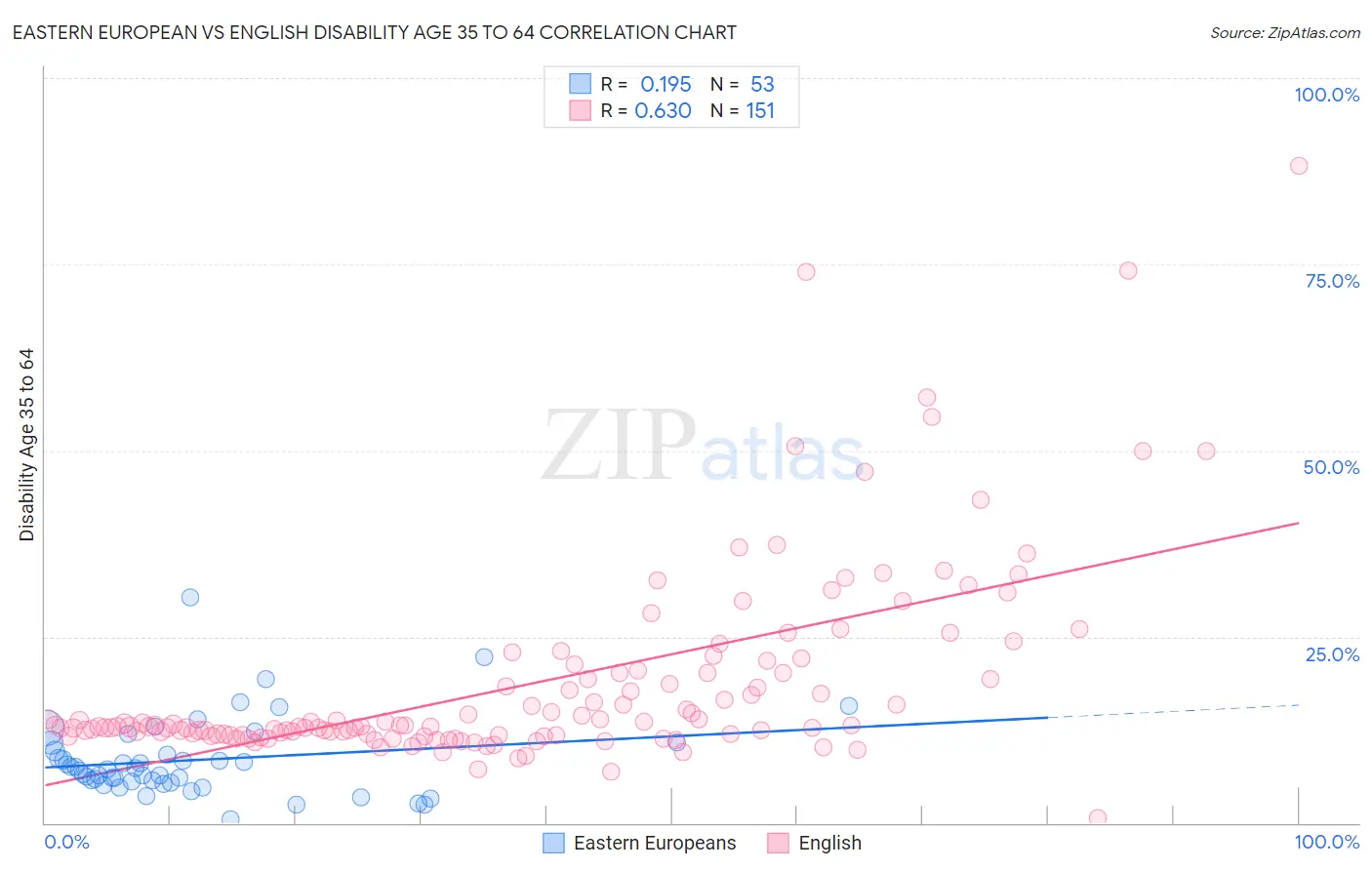Eastern European vs English Disability Age 35 to 64
COMPARE
Eastern European
English
Disability Age 35 to 64
Disability Age 35 to 64 Comparison
Eastern Europeans
English
10.0%
DISABILITY AGE 35 TO 64
99.7/ 100
METRIC RATING
62nd/ 347
METRIC RANK
12.4%
DISABILITY AGE 35 TO 64
0.6/ 100
METRIC RATING
259th/ 347
METRIC RANK
Eastern European vs English Disability Age 35 to 64 Correlation Chart
The statistical analysis conducted on geographies consisting of 460,814,379 people shows a poor positive correlation between the proportion of Eastern Europeans and percentage of population with a disability between the ages 34 and 64 in the United States with a correlation coefficient (R) of 0.195 and weighted average of 10.0%. Similarly, the statistical analysis conducted on geographies consisting of 578,471,169 people shows a significant positive correlation between the proportion of English and percentage of population with a disability between the ages 34 and 64 in the United States with a correlation coefficient (R) of 0.630 and weighted average of 12.4%, a difference of 24.8%.

Disability Age 35 to 64 Correlation Summary
| Measurement | Eastern European | English |
| Minimum | 0.52% | 0.65% |
| Maximum | 30.4% | 88.2% |
| Range | 29.8% | 87.6% |
| Mean | 8.4% | 18.7% |
| Median | 7.3% | 12.9% |
| Interquartile 25% (IQ1) | 5.5% | 11.8% |
| Interquartile 75% (IQ3) | 10.2% | 20.2% |
| Interquartile Range (IQR) | 4.7% | 8.4% |
| Standard Deviation (Sample) | 5.3% | 13.2% |
| Standard Deviation (Population) | 5.2% | 13.1% |
Similar Demographics by Disability Age 35 to 64
Demographics Similar to Eastern Europeans by Disability Age 35 to 64
In terms of disability age 35 to 64, the demographic groups most similar to Eastern Europeans are Immigrants from Spain (10.0%, a difference of 0.10%), Immigrants from Czechoslovakia (10.0%, a difference of 0.12%), Immigrants from South America (9.9%, a difference of 0.22%), Immigrants from Romania (10.0%, a difference of 0.31%), and Immigrants from Poland (10.0%, a difference of 0.39%).
| Demographics | Rating | Rank | Disability Age 35 to 64 |
| Peruvians | 99.8 /100 | #55 | Exceptional 9.9% |
| South Americans | 99.8 /100 | #56 | Exceptional 9.9% |
| Colombians | 99.8 /100 | #57 | Exceptional 9.9% |
| Armenians | 99.8 /100 | #58 | Exceptional 9.9% |
| Immigrants | Sweden | 99.7 /100 | #59 | Exceptional 9.9% |
| Immigrants | South America | 99.7 /100 | #60 | Exceptional 9.9% |
| Immigrants | Spain | 99.7 /100 | #61 | Exceptional 10.0% |
| Eastern Europeans | 99.7 /100 | #62 | Exceptional 10.0% |
| Immigrants | Czechoslovakia | 99.7 /100 | #63 | Exceptional 10.0% |
| Immigrants | Romania | 99.7 /100 | #64 | Exceptional 10.0% |
| Immigrants | Poland | 99.6 /100 | #65 | Exceptional 10.0% |
| Cubans | 99.6 /100 | #66 | Exceptional 10.0% |
| Immigrants | Uzbekistan | 99.5 /100 | #67 | Exceptional 10.1% |
| Immigrants | Switzerland | 99.5 /100 | #68 | Exceptional 10.1% |
| Immigrants | Eastern Europe | 99.5 /100 | #69 | Exceptional 10.1% |
Demographics Similar to English by Disability Age 35 to 64
In terms of disability age 35 to 64, the demographic groups most similar to English are Welsh (12.4%, a difference of 0.12%), Mexican (12.4%, a difference of 0.20%), German Russian (12.5%, a difference of 0.25%), Malaysian (12.5%, a difference of 0.40%), and Scottish (12.4%, a difference of 0.46%).
| Demographics | Rating | Rank | Disability Age 35 to 64 |
| Irish | 1.0 /100 | #252 | Tragic 12.3% |
| Dutch | 1.0 /100 | #253 | Tragic 12.3% |
| Hawaiians | 0.9 /100 | #254 | Tragic 12.3% |
| Japanese | 0.8 /100 | #255 | Tragic 12.3% |
| Scottish | 0.8 /100 | #256 | Tragic 12.4% |
| Mexicans | 0.7 /100 | #257 | Tragic 12.4% |
| Welsh | 0.6 /100 | #258 | Tragic 12.4% |
| English | 0.6 /100 | #259 | Tragic 12.4% |
| German Russians | 0.5 /100 | #260 | Tragic 12.5% |
| Malaysians | 0.5 /100 | #261 | Tragic 12.5% |
| Senegalese | 0.5 /100 | #262 | Tragic 12.5% |
| Immigrants | Zaire | 0.4 /100 | #263 | Tragic 12.5% |
| Immigrants | Portugal | 0.4 /100 | #264 | Tragic 12.5% |
| Marshallese | 0.4 /100 | #265 | Tragic 12.5% |
| Whites/Caucasians | 0.3 /100 | #266 | Tragic 12.6% |